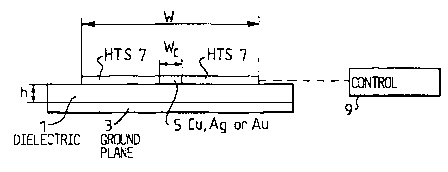Some of the information on this Web page has been provided by external sources. The Government of Canada is not responsible for the accuracy, reliability or currency of the information supplied by external sources. Users wishing to rely upon this information should consult directly with the source of the information. Content provided by external sources is not subject to official languages, privacy and accessibility requirements.
Any discrepancies in the text and image of the Claims and Abstract are due to differing posting times. Text of the Claims and Abstract are posted:
| (12) Patent Application: | (11) CA 2337874 |
|---|---|
| (54) English Title: | A SWITCHABLE INDUCTOR |
| (54) French Title: | INDUCTEUR COMMUTABLE |
| Status: | Deemed Abandoned and Beyond the Period of Reinstatement - Pending Response to Notice of Disregarded Communication |
| (51) International Patent Classification (IPC): |
|
|---|---|
| (72) Inventors : |
|
| (73) Owners : |
|
| (71) Applicants : |
|
| (74) Agent: | MARKS & CLERK |
| (74) Associate agent: | |
| (45) Issued: | |
| (86) PCT Filing Date: | 1999-07-16 |
| (87) Open to Public Inspection: | 2000-01-27 |
| Availability of licence: | N/A |
| Dedicated to the Public: | N/A |
| (25) Language of filing: | English |
| Patent Cooperation Treaty (PCT): | Yes |
|---|---|
| (86) PCT Filing Number: | PCT/SE1999/001283 |
| (87) International Publication Number: | WO 2000004603 |
| (85) National Entry: | 2001-01-16 |
| (30) Application Priority Data: | ||||||
|---|---|---|---|---|---|---|
|
An inductor for microwave frequencies has a substantially planar structure and
is constructed of a transmission line designed as a linear microstrip element
made of a central line (5) comprising normal electrically conducting material,
such as a suitable metal. The microstrip element has a width which is varied
by making areas (7) at sides of the central line (5) superconducting. In
changing the effective width of the microstrip the inductance thereof is
changed accordingly. The areas at the sides of the microstrip element are
located directly at the central, normal metal conductor. These areas have in
the non-superconducting state some electrical conductivity which can be rather
low but owing to the fact that they contact the normal central metal conductor
only at a very narrow edge instead of contacting it at a large surface they do
not significantly affect the transmission characteristics of the transmission
path when the superconducting areas (7) are in their normal state.
L'invention concerne un inducteur pour hyperfréquences, de structure sensiblement plane, constitué d'une ligne de transmission conçue sous la forme d'un élément microbande linéaire comportant une ligne (5) centrale comprenant un matériau électroconducteur normal, par exemple un métal approprié. La largeur de l'élément microbande peut être modifiée en rendant les zones (7) de part et d'autre de la ligne (5) centrale supraconductrices. La modification de la largeur effective de la microbande permet de modifier en conséquence l'induction de ladite microbande. Les zones de part et d'autre de l'élément microbande se situent directement u niveau du conducteur métallique central. Ces zones possèdent, à l'état non supraconducteur, une certaine conductivité électrique, qui peut être plutôt faible mais qui, du fait qu'elles ne sont au contact du conducteur métallique normal qu'au niveau d'une arête très étroite et non au niveau d'une large surface, n'ont qu'une faible incidence sur les caractéristiques de transmission du chemin de transmission, lorsque les zones supraconductrices se trouvent dans leur état normal.
Note: Claims are shown in the official language in which they were submitted.
Note: Descriptions are shown in the official language in which they were submitted.

2024-08-01:As part of the Next Generation Patents (NGP) transition, the Canadian Patents Database (CPD) now contains a more detailed Event History, which replicates the Event Log of our new back-office solution.
Please note that "Inactive:" events refers to events no longer in use in our new back-office solution.
For a clearer understanding of the status of the application/patent presented on this page, the site Disclaimer , as well as the definitions for Patent , Event History , Maintenance Fee and Payment History should be consulted.
| Description | Date |
|---|---|
| Inactive: IPC expired | 2023-01-01 |
| Application Not Reinstated by Deadline | 2004-07-16 |
| Time Limit for Reversal Expired | 2004-07-16 |
| Deemed Abandoned - Failure to Respond to Maintenance Fee Notice | 2003-07-16 |
| Letter Sent | 2002-02-19 |
| Inactive: Single transfer | 2002-01-14 |
| Inactive: Cover page published | 2001-05-01 |
| Inactive: First IPC assigned | 2001-04-25 |
| Inactive: Courtesy letter - Evidence | 2001-04-03 |
| Inactive: Notice - National entry - No RFE | 2001-03-28 |
| Application Received - PCT | 2001-03-24 |
| Application Published (Open to Public Inspection) | 2000-01-27 |
| Abandonment Date | Reason | Reinstatement Date |
|---|---|---|
| 2003-07-16 |
The last payment was received on 2002-07-16
Note : If the full payment has not been received on or before the date indicated, a further fee may be required which may be one of the following
Please refer to the CIPO Patent Fees web page to see all current fee amounts.
| Fee Type | Anniversary Year | Due Date | Paid Date |
|---|---|---|---|
| MF (application, 2nd anniv.) - standard | 02 | 2001-07-16 | 2001-01-16 |
| Basic national fee - standard | 2001-01-16 | ||
| Registration of a document | 2002-01-14 | ||
| MF (application, 3rd anniv.) - standard | 03 | 2002-07-16 | 2002-07-16 |
Note: Records showing the ownership history in alphabetical order.
| Current Owners on Record |
|---|
| TELEFONAKTIEBOLAGET LM ERICSSON |
| Past Owners on Record |
|---|
| ERLAND WIKBORG |
| SHU-ANG ZHOU |